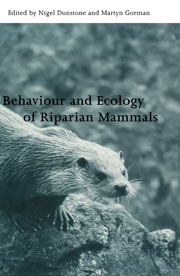Book contents
- Frontmatter
- Contents
- List of contributors
- Preface
- 1 Adaptations to the semi-aquatic habit and habitat
- 2 Physiological challenges in semi-aquatic mammals: swimming against the energetic tide
- 3 Diving capacity and foraging behaviour of the water shrew (Neomys fodiens)
- 4 Habitat use by water shrews, the smallest of amphibious mammals
- 5 The importance of the riparian environment as a habitat for British bats
- 6 A preliminary study of the behaviour of the European mink Mustela lutreola in Spain, by means of radiotracking
- 7 The demography of European otters Lutra lutra
- 8 Habitat use and conservation of otters (Lutra lutra) in Britain: a review
- 9 The relationship between riverbank habitat and prey availability and the distribution of otter (Lutra lutra) signs: an analysis using a geographical information system
- 10 Influence of altitude on the distribution, abundance and ecology of the otter (Lutra lutra)
- 11 Diets of semi-aquatic carnivores in northern Belarus, with implications for population changes
- 12 Otter (Lutra lutra) prey selection in relation to fish abundance and community structure in two different freshwater habitats
- 13 Diet, foraging behaviour and coexistence of African otters and the water mongoose
- 14 Feeding ecology of the smooth-coated otter Lutra perspicillata in the National Chambal Sanctuary, India
- 15 Population trends of hippopotami in the rivers of the Kruger National Park, South Africa
- 16 Reproductive strategies of female capybaras: dry-season gestation
- 17 The continuing decline of the European mink Mustela lutreola: evidence for the intraguild aggression hypothesis
- 18 Otters and pollution in Spain
- 19 The rapid impact of resident American mink on water voles: case studies in lowland England
- 20 Status, habitat use and conservation of giant otter in Peru
- Index
3 - Diving capacity and foraging behaviour of the water shrew (Neomys fodiens)
Published online by Cambridge University Press: 03 May 2010
- Frontmatter
- Contents
- List of contributors
- Preface
- 1 Adaptations to the semi-aquatic habit and habitat
- 2 Physiological challenges in semi-aquatic mammals: swimming against the energetic tide
- 3 Diving capacity and foraging behaviour of the water shrew (Neomys fodiens)
- 4 Habitat use by water shrews, the smallest of amphibious mammals
- 5 The importance of the riparian environment as a habitat for British bats
- 6 A preliminary study of the behaviour of the European mink Mustela lutreola in Spain, by means of radiotracking
- 7 The demography of European otters Lutra lutra
- 8 Habitat use and conservation of otters (Lutra lutra) in Britain: a review
- 9 The relationship between riverbank habitat and prey availability and the distribution of otter (Lutra lutra) signs: an analysis using a geographical information system
- 10 Influence of altitude on the distribution, abundance and ecology of the otter (Lutra lutra)
- 11 Diets of semi-aquatic carnivores in northern Belarus, with implications for population changes
- 12 Otter (Lutra lutra) prey selection in relation to fish abundance and community structure in two different freshwater habitats
- 13 Diet, foraging behaviour and coexistence of African otters and the water mongoose
- 14 Feeding ecology of the smooth-coated otter Lutra perspicillata in the National Chambal Sanctuary, India
- 15 Population trends of hippopotami in the rivers of the Kruger National Park, South Africa
- 16 Reproductive strategies of female capybaras: dry-season gestation
- 17 The continuing decline of the European mink Mustela lutreola: evidence for the intraguild aggression hypothesis
- 18 Otters and pollution in Spain
- 19 The rapid impact of resident American mink on water voles: case studies in lowland England
- 20 Status, habitat use and conservation of giant otter in Peru
- Index
Summary
Introduction
With regard to semi–aquatic mammals, Schröpfer & Stubbe (1992) distinguished three riparian guilds: the herbivores with the water vole and the beaver; the megacarnivores with the mink and the otter; and the macrocarnivores with water shrews and desmans. Among water shrews, the evolution of aquatic foraging behaviour occurred several times: Nectogale and Chimarrogale in Asia, several species of the genus Sorex in America, and Neomys in Eurasia (Churchfield, 1990). The fairly common European water shrew N. fodiens is the best known. However, the reports on the degree of adaptation to the water habitat are conflicting. Therefore some important findings from the literature are reviewed in this introduction, whereas new data are presented in the following sections.
The swimming locomotion of water shrews was analysed by Ruthardt & Schröpfer (1985) and Köhler (1991), and the related morphological adaptation were reviewed by Hutterer (1985) and Churchfield (this volume pp. 49–51). They obviously present a compromise between the requirements for activity on land and in the water.
Thermoregulation is a major problem for semi–aquatic mammals, because heat conductance in water is 25–fold greater than in air (Calder, 1969). According to this author, the body temperature of immersed American Sorex palustris dropped by a rate of 2.8 °C per min. However, this may be an experimental artefact, because Neomys fodiens can maintain its body temperature at 37 °C during an immersion of 6 min (Vogel, 1990).
- Type
- Chapter
- Information
- Behaviour and Ecology of Riparian Mammals , pp. 31 - 48Publisher: Cambridge University PressPrint publication year: 1998
- 4
- Cited by



